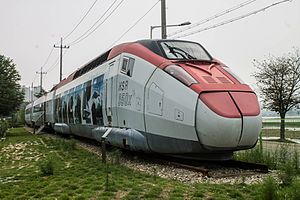HSR-350x
| HSR-350x (Hanvit 350) | |
|---|---|

The preserved HSR-350x in Uiwang in 2015 summer.
|
|
| In service | 2002-2008 |
| Manufacturer | Rotem |
| Family name | Hanvit |
| Constructed | 1996-2002 |
| Number built | 1 |
| Number in service | 0 |
| Formation |
P+M+3T+M'+P
|
| Operator(s) | KRRI |
| Depot(s) | Osong |
| Line(s) served | Gyeongbu High Speed Railway |
| Specifications | |
| Car body construction |
traction heads: steel passenger cars: aluminum |
| Train length | 145.17 m (476.3 ft) |
| Car length |
traction heads: 22,690 mm (893.3 in) powered passenger cars: 21,845 mm (860.0 in) unpowered passenger cars: 18,700 mm (736.2 in) |
| Width |
traction heads: 2,814 mm (110.8 in) passenger cars: 2,970 mm (116.9 in) |
| Height |
powered cars: 4,055 mm (159.6 in) unpowered passenger cars: 3,690 mm (145.3 in) |
| Floor height | 1,212 mm (47.7 in) |
| Maximum speed |
achieved in tests: 352.4 km/h (219.0 mph) planned in tests/design: 385 km/h (239 mph) planned in service: 350 km/h (217 mph) |
| Weight |
empty: 310 t (342 short tons) loaded: 332 t (366 short tons) adhesive weight: 204 t (225 short tons) axle load: max. 17 t (19 short tons) |
| Traction system | 12 three-phase asynchronous induction motors 6 IGCT-based VVVF inverters (1 per bogie) |
| Power output | 12 x 1,100 kW (1,500 hp) total 13,200 kW (17,700 hp) |
| Auxiliaries | 1.4+0.7 MW, supplying 670 V DC |
| Electric system(s) | 25 kV/60 Hz AC catenary |
| Current collection method | pantograph (single-arm) |
| UIC classification | Bo'Bo' + Bo'(2)(2)(2)(2)Bo' + Bo'Bo' |
| Bogies | Jacobs bogies between intermediate cars |
| Braking system(s) |
|
| Safety system(s) | TVM 430 (ATC), ATS |
| Coupling system | Scharfenberg (emergency) |
| Multiple working | - |
| Track gauge | 1,435 mm (4 ft 8 1⁄2 in) standard gauge |
P+M+3T+M'+P
HSR-350x, alternatively called G7, KHST or NG-KTX, and later officially renamed Hanvit 350, is a South Korean experimental high-speed train. It was developed and built in a joint project of government research institutes, universities and private companies that started in 1996, which aimed to reduce import dependence in high-speed rail technology. New components developed for the HSR-350x included motors, electronics, and the carbody of passenger cars. Test runs were conducted between 2002 and 2008. The experimental train achieved the South Korean rail speed record of 352.4 km/h (219.0 mph) in 2004. The HSR-350x was the basis for Korail's KTX-II (KTX-Sancheon) commercial high-speed trains.
When South Korea started its high-speed rail project, rolling stock and infrastructure was built in the framework of a technology transfer agreement between GEC-Alsthom (today Alstom), the main maker of French TGV high-speed trains, and South Korean companies. The first trains for Korea Train Express service, the KTX-I, were derived from the TGV Réseau, and built both by Alstom and Rotem (today Hyundai Rotem).
The technology transfer agreement did not provide for a complete control of manufacturing processes, and construction involved the import of parts. To increase the domestic added value, and to further improve the technology, in December 1996, South Korea's Ministry of Construction and Transportation (MOCT) started a project named G7 to develop domestic high-speed rail technology. The project involved 10 government research agencies, 16 universities and 35 private companies, and employed over a thousand people. The main partners were the Korea Railroad Research Institute (KRRI), the Korea Institute of Industrial Technology (KITECH), and rolling stock manufacturer Rotem.
Due to the strong interdependencies of vehicle and infrastructure parameters in high-speed rail technology, the G7 program first focused on the compatibility with other components like track, catenary, signalling, and train control. Sub-projects dealt with bridge design, improved pantograph design, and catenary in tunnels. Technologies used in high-speed line construction, including rails and catenary in tunnels, were adapted for use in conventional line upgrades, to enable the operation of KTX trains on such lines. The program also dealt with problems discovered during the operation of KTX-I trains, including a snaking movement of the articulated train around a speed of 150 km/h (93 mph) in winter, which was addressed by increasing wheel conicity.
...
Wikipedia
